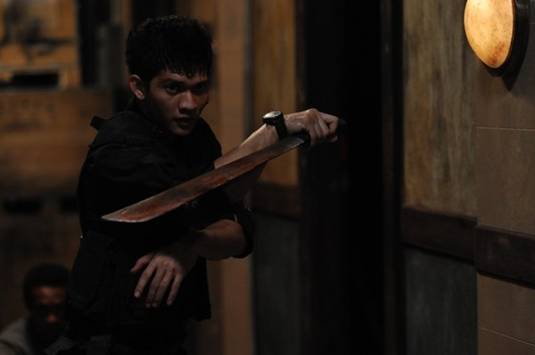[This is the first in a series of dispatches relating to the New Directors/New Films series, running between March 21, 2012 and April 1, 2011 at MOMA and the Film Society of Lincoln Center.]
It’s difficult not to take grand glee in an action movie with an aesthetic partially inspired by Eddie Adams’s famous photo of Nguyen Van Lem getting his head blown off. In Gareth Evans’s beautifully brutal new film, The Raid: Redemption, angry heads pop into frame and are pistoled, knifed, and punctured against crumbling chrome walls with rhythmic panache. I spent much of the movie chortling over the audacity.
Last year, I argued that the main difference between a great low-class action movie (Shoot ‘Em Up) and unpardonable trash (Kick-Ass) is that the former invites the reader to make sense of the madness on screen, while the latter wishes to dictate how the audience should react (generally with some knowing musical cue where the irony is ham-handed).
I am pleased to report that The Raid falls into the first category and is very entertaining indeed. For all of The Raid‘s over-the-top violence (there is one amazing scene in which a single man battles a machete gang with near balletic dexterity), Evans — a Welshman now operating in Indonesia — isn’t afraid to bedazzle with his camera. A crane shot lowers from above as twenty elite cops methodically leave a truck with their weapons. But Evans doesn’t stop there. He continues the shot on Steadicam.
Here is a movie where characters chop through the floor with an axe, jump to the level below them, and the camera follows — whether through CGI or a bona-fide stuntman, I know not. And if, for some reason, you can’t appreciate that, consider how Mikhail Kalatozov’s camera in I Am Cuba scaled walls and followed a flag across a crowded street. If cinema can transport us into places we wouldn’t ordinarily go, why should we withhold our praise when an action movie does the same thing?
I haven’t even discussed the way in which Evans uses slow motion. There is a stunning shot early in the film where one of the tenants shouts up a stairwell that the police have arrived. And while this shot continues in slothful time, we see a flying bullet puncture through the wall behind him.
Evans is also committed to barbarous triplets. If you’re a bad guy in The Raid, you won’t just get a gunshot to the head. You’ll get three. If you’re getting pounded against the wall, then the man who is kicking your ass will do his best to make sure you get smashed in three separate places on your way down to death on the floor. The quiet math rock part of me appreciated all this. Death does indeed happen in threes.
And while some of the hallway fights get a little repetitive near the end, exposing the ridiculous and threadbare plot (which turns out to be a knockoff of A Better Tomorrow: two brothers, one a cop and the other a criminal), Evans is very good about keeping the action and the locations varied up enough for us not to notice. He has stuntmen clamber up walls and even has his characters hide inside them. One gets the sense that Evans has truly considered every nook and cranny of his location. And every strike of the knife.
It also helps that the movie contains some unusual dialogue. When the villain was informed at an early point that at least thirty of his tenants who paid rent were now spread across the walls, I knew that I was in capable hands. If I happened to be a violent maniac and property owner, I’d certainly want my underlings to inform me about any recent change in revenue. “Squeezing a trigger?” asks one man to another. “That’s like ordering takeout.” This half-assed philosophical stance gives two men an excuse to get into a protracted martial arts fight.
The line may also anticipate the cult audience this film is likely to attract. For The Raid isn’t ephemeral takeout. It’s the hip new dive you want to tell your friends about before everybody else discovers it.
